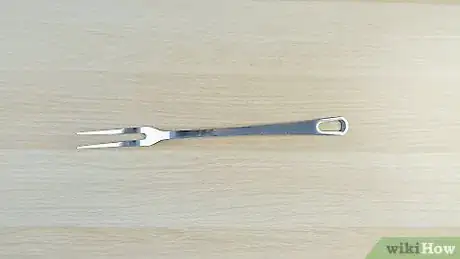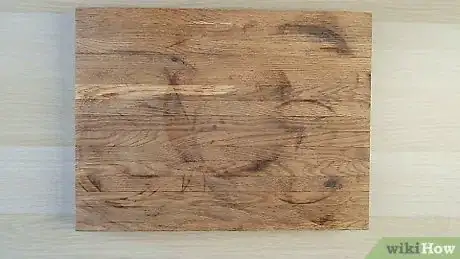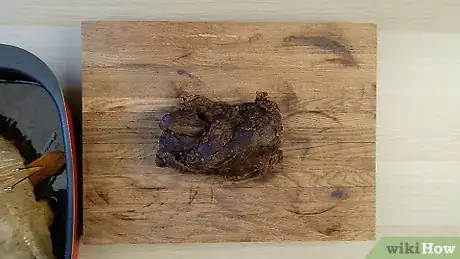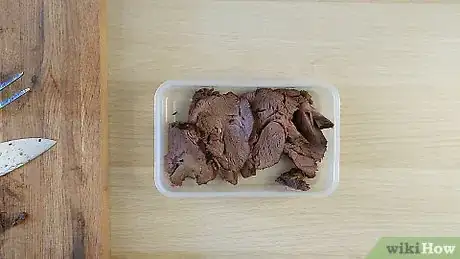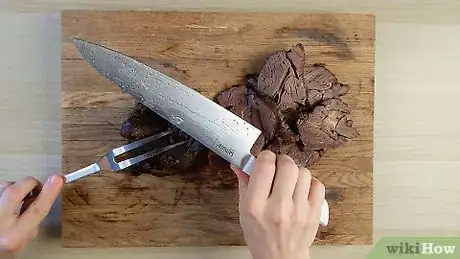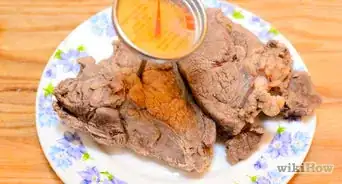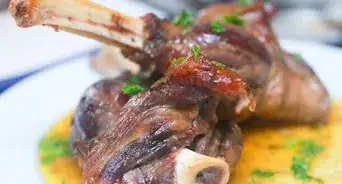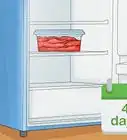This article was co-authored by wikiHow Staff. Our trained team of editors and researchers validate articles for accuracy and comprehensiveness. wikiHow's Content Management Team carefully monitors the work from our editorial staff to ensure that each article is backed by trusted research and meets our high quality standards.
The wikiHow Video Team also followed the article's instructions and verified that they work.
This article has been viewed 24,707 times.
Learn more...
If you’re making a delicious roast beef meal, one thing you should know how to do is cut the beef properly. There are a few different aspects of cutting roast beef, such as what tools to use, what direction to cut the beef, and how much of it to cut, that are more nuanced than you may think. Fortunately, once you understand these nuances, it’s easy to cut roast beef in a way that makes it even more tender, succulent, and delicious!
Steps
Using the Best Tools
-
1Use a long, sharp knife specifically designed for carving. This type of knife will give you the smoothest cuts when carving your roast beef. If you don’t have a carving knife, a serrated bread knife will also work, although your cuts won’t look as neat.[1]
- You can buy special carving knives at any store that sells cooking supplies.
- When it comes to carving knives, the rule of thumb is: the longer and sharper your knife, the better.
- You can also use an electric carving knife to make the job easier on yourself. However, electric carving knives generally produce less neat cuts than traditional knives.
-
2Make sure you have a 2-prong carving fork to hold the beef with. This will hold the roast beef in place when you go to cut it and will prevent it from sliding around on the carving tray. Most carving forks have 2 prongs, but a 3-prong fork would also work.[2]
- An ordinary fork probably won’t be long and thick enough to adequately hold the beef steady as you cut it.
Advertisement -
3Opt for a metal carving tray with raised sides, if you have one. The spikes and upraised sides of this type of tray will help to keep the beef in place as you cut it, as well as prevent the juices from spilling. If you don’t have a metal carving tray, the next best thing to use is a large wooden cutting board.[3]
-
4Consider getting a knife sharpener if your knives are all dull. Having a sharp knife makes the task of cutting beef a lot easier and safer. A knife sharpener is a particularly good investment if you cook roast beef fairly often.[4]
- You can buy a knife sharpener at most cooking supply stores.
Carving Roast Beef Properly
-
1Let the beef rest for 10-15 minutes so it can reabsorb the juices. After you’ve cooked the roast beef, take it out of the oven and wrap it in aluminum foil. This will keep the beef hot as it marinates in its own juices.[5]
- Letting the beef rest will not only make your meat juicier, but it will also be easier to cut as a result.
- Be sure to use oven mitts when taking the roast beef out of the oven.
-
2Identify the “grain” of the beef so you know where to cut it. The “grain” of meat refers to the direction that the muscle fibers are aligned, either horizontally or vertically. The grain will appear as visible, usually white streaks on the surface of your meat.[6]
- When cutting beef, it’s important to cut across the grain, so that the beef is less tough and easier to chew. Cutting across the grain means severing these muscle fibers when you carve the roast.
-
3Place the roast beef in the carving tray or on the cutting board. It’ll be much easier to carve the beef on a cutting surface rather than in the roasting pan. If the beef is too hot to touch, use oven mitts to grip the beef through the aluminum foil and move it to the carving tray.[7]
-
4Insert the carving fork and position the knife near the end of the roast. Stab the roast beef with the carving fork somewhere between you and where you’ve positioned the knife, in case of accidents. Place the knife over 1 end of the beef instead of in the middle of the roast.[8]
- This way, when you begin cutting the roast beef, the rest of the meat will be kept together in a single piece that you can store more easily.
-
5Use a smooth slicing motion to cut the beef across the grain. Try to glide the knife through the beef in 1 or 2 motions to avoid shredding the meat as you cut it. Be sure you’re carving across the grain and severing the beef’s muscle fibers.[9]
- For example, if the beef’s muscle fibers move from left to right, then you should be cutting the beef from top to bottom.
- If you’re using a serrated bread knife instead of a carving knife, you may need to use a sawing motion in order to cut the beef.
-
6Make your slices 1⁄4 to 1⁄2 inch (0.64 to 1.27 cm) thick. This is the typical thickness that roast beef is cut for sandwiches and meals. However, you can also go for thicker, juicier slices, if that’s your preference.[10]
- There’s no real limit to how thick your slices can be, although slices that are thicker than 1 inch (2.5 cm) may be a bit hard for people to eat.
Tip: If you want to cut very thin slices of roast beef for sandwiches, you may want to use a meat slicer to make consistent thin slices.
-
7Place any leftover roast beef in an airtight container to store it. Once you’ve finished slicing it, store the rest of your roast beef in a shallow airtight container or wrap it tightly in aluminum foil. Place your leftover beef in the refrigerator or freezer within 2 hours of cooking.[11]
- Your beef will stay fresh in the refrigerator for 3-4 days or in the freezer for 2-3 months.
- If you don’t have aluminum foil, you can also wrap the beef in plastic wrap.
Avoiding Common Mistakes
-
1Don’t cut off more meat than you’re going to use in the meal. Sliced roast beef will lose its juices more quickly than roast beef that hasn’t been sliced. This means that if you want to save any beef for future use, it’s best to store it in a single lump rather than in slices.[12]
- If you end up having leftover sliced roast beef, eating it with au jus or gravy is a good way to avoid it being too dry when you eat it as leftovers.
-
2Hold the knife with a loose but steady grip when you’re cutting the beef. This will help prevent you from making “unattractive” cuts of meat by cutting it in a more fluid motion. However, make sure to hold the knife steady enough that you don’t lose your grip on it.[13]
-
3Refrain from slicing the beef less than 1⁄4 inch (0.64 cm) thick. If the beef is too thin, it won’t do as good a job of retaining its juices. Granted, the thickness of roast beef slices is a matter of personal preference, so feel free to slice your beef very thin if that’s what you prefer.[14]
- Most cooks say you should definitely never slice roast beef less than 1⁄8 inch (0.32 cm) thick.
Things You’ll Need
- Carving knife
- Carving fork
- Carving tray
- Knife sharpener (optional)
- Aluminum foil
References
- ↑ https://www.telegraph.co.uk/food-and-drink/scotch-beef/whats-the-best-way-to-carve-beef/
- ↑ https://www.telegraph.co.uk/food-and-drink/scotch-beef/whats-the-best-way-to-carve-beef/
- ↑ https://www.telegraph.co.uk/food-and-drink/scotch-beef/whats-the-best-way-to-carve-beef/
- ↑ https://www.telegraph.co.uk/food-and-drink/scotch-beef/whats-the-best-way-to-carve-beef/
- ↑ https://www.recipetips.com/kitchen-tips/t--392/carving-beef.asp
- ↑ https://www.thekitchn.com/heres-exactly-how-to-slice-meat-against-the-grain-and-why-you-should-be-doing-it-meat-basics-215798
- ↑ https://www.recipetips.com/kitchen-tips/t--392/carving-beef.asp
- ↑ https://www.recipetips.com/kitchen-tips/t--392/carving-beef.asp
- ↑ https://www.youtube.com/watch?v=SRUZJv31R1I#t=57s
- ↑ https://www.recipetips.com/kitchen-tips/t--392/carving-beef.asp
- ↑ https://www.stilltasty.com/fooditems/index/16498
- ↑ https://www.telegraph.co.uk/food-and-drink/scotch-beef/whats-the-best-way-to-carve-beef/
- ↑ https://www.telegraph.co.uk/food-and-drink/scotch-beef/whats-the-best-way-to-carve-beef/
- ↑ https://www.telegraph.co.uk/food-and-drink/scotch-beef/whats-the-best-way-to-carve-beef/

